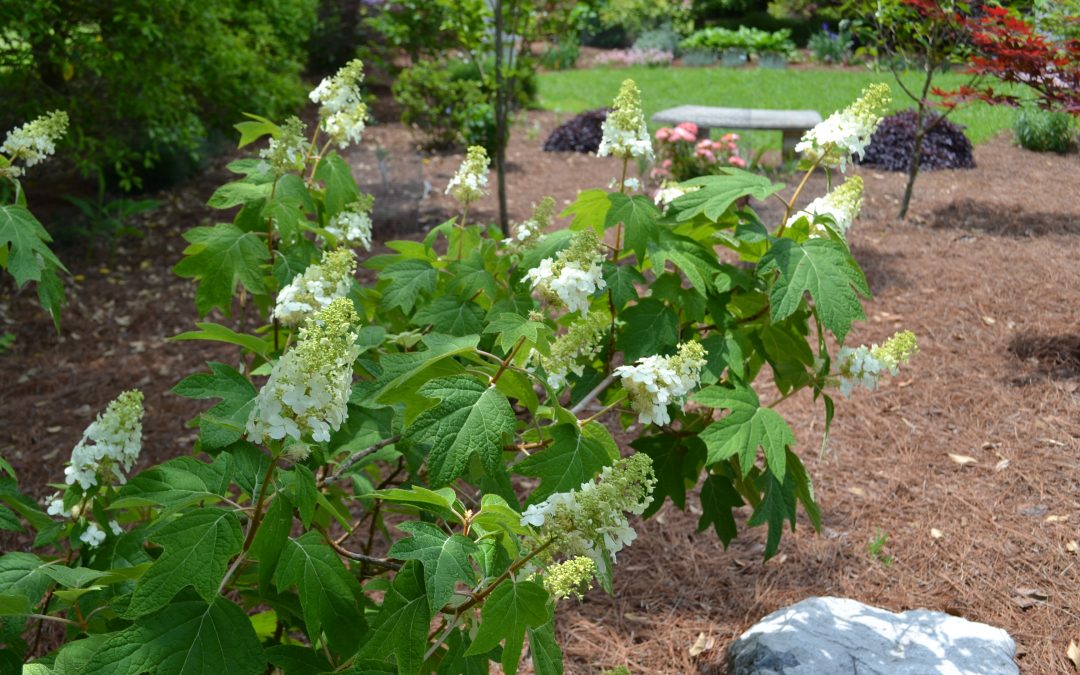
by Beth Bolles | Jun 20, 2025
Shade is a wonderful feature in the landscape as we move into our summer months. It can also offer an opportunity to include a different palette of beautiful plants the bring color and brighteness to some filtered shade or full shade locations.
Here are a few plants to consider for those low light areas of the yard.
The native oakleaf hydrangea, Hydrangea quercifolia will do well in dappled shade spots. The leaves are attractive on their own but the addition of large flowers make it very showy. This native hydrangea will like a little moisture but soils should be well drained. A little morning sun is fine but afternoon shade is very helpful as the summer months progress.
The old standard Japanese aucuba, Acuba japonica, is a favorite with it’s green leaves speckled with yellow. New growth is damaged by sun so this evergreen shrub is best with a good amount of shade. Be sure to place in a spot with good air circulation to make the environment less conducive to some plant pests.
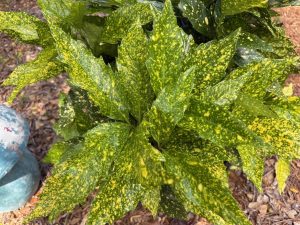
Each Aucuba leaf has a unique pattern. Photo by Beth Bolles, UF IFAS Extension Escambia County.
One of the shrimp plants that really needs shade is the White shrimp plant, Justicia betonica. Although this can be damaged in freezing weather, it is worth replanting every spring in a small grouping. Plants are easily started from cuttings and sometimes they will return from roots in the protected shade areas.
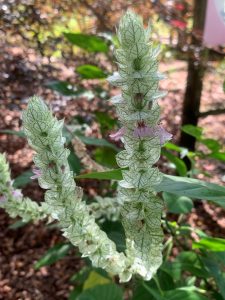
White bracts with pink flowers of White shrimp plant. Photo by Beth Bolles, UF IFAS Extension Escambia County.
An annual that is very showy for shade is related to the shrimp plant. Persian shield, Strobilanthes dyerianus is grown for it’s iridescent purple and silver foliage. It thrives in our heat with a little water when rainfall is lacking. It grows well either planted in the ground or in a container to provide bright color amongst the green foliage plants of your shady spot.
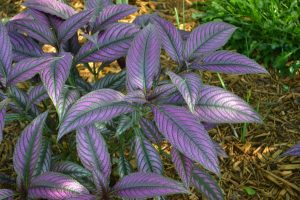
A bit of dappled morning sunlight on the Persian shield leaves. Photo by Beth Bolles, UF IFAS Extension Escambia County.
Most people know the Cast iron plant, Aspidistra elatior, which is a full shade plant. Plants that receive too much sunlight with have scalding spots. Although green foliage is attractive in summer, consider one of the cultivars with various types of variegation. You may choose a selection with white or yellow stripes through leaves or a plant with lots of white spots throughout green leaves.

by Beth Bolles | Aug 7, 2019
We are always on the lookout for an attractive plant for our landscape. At the nursery, some plants have a more difficult time gaining our attention. They may not be as showy, possessing neither colorful flowers nor bold foliage. In these cases, we could be missing out on low maintenance plant that offers its own form of beauty in the right landscape spot.
One plant that I love is the Japanese plum yew (Cephalotaxus harringtonia), especially the spreading form ‘Prostrata’. In the nursery container, this plant is nothing special but once established in the landscape it performs well. The conifer type leaves are an attractive dark green and the ‘Prostrata’ selection is low growing to about 2 to 3 feet. An advantage too is that growth is slow so it won’t take over or require routine pruning.
Japanese plum yews grow best in partial shade and once established will be fine with rainfall. For a shadier side of the home, the spreading plum yew has a place as an evergreen foundation plant too.

Japanese plum yew in a shaded garden. Photo by Beth Bolles, UF IFAS Extension Escambia County
If the ‘Prostrata’ selection is too low growing for you, consider the ‘Fastigiata’ cultivar that will grow upright to about 8 feet with a 5 foot spread.
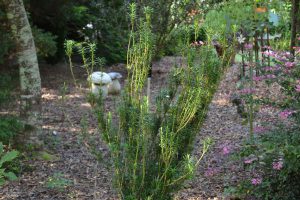
A year old planting of upright Japanese plum yew in filtered light. Photo by Beth Bolles, UF IFAS Extension Escambia County
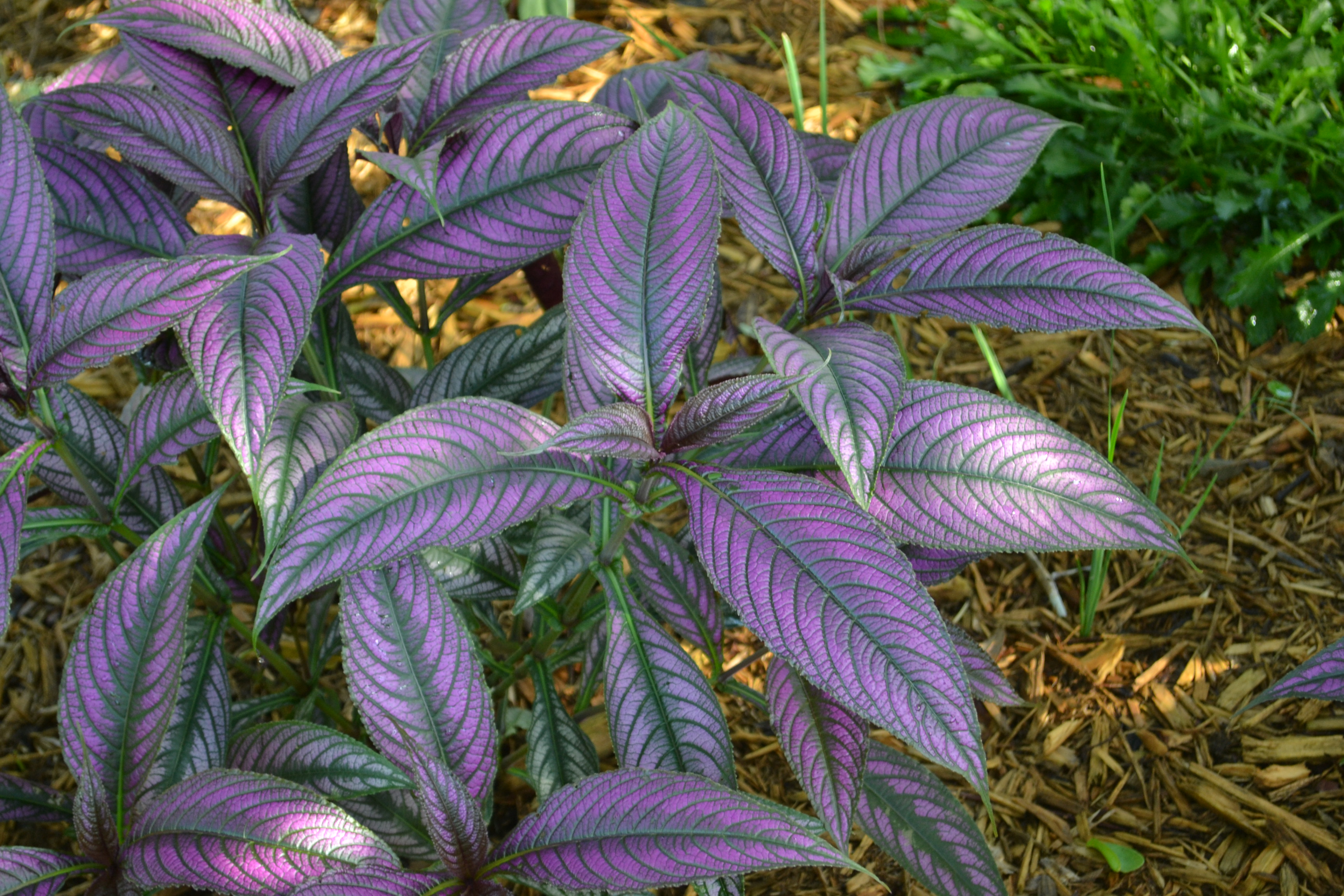
by Beth Bolles | Feb 26, 2018
Many landscapes have areas with tree canopies that lend themselves to becoming an attractive low maintenance garden area. Too often we may try to fight our shade by growing turf or pruning trees to allow more sunlight. The low maintenance approach can be to enhance your shaded area with plants and features that are both adaptable to low light and offer seasonal interest.
There are a variety of plants that perform well in the shade of a tree canopy, including evergreens, flowering perennials, and groundcovers. A key to remember is to make sure soil moisture matches the plant you choose. Tree roots will compete with plants you install so supplemental irrigation may be needed during periods when rainfall is lacking. Another consideration is that tree root systems may prevent a lot of digging for establishment so choose plants that may spread out on their own from the main plants. A few examples include Netted chain fern, Toadlily, Chinese ground orchid, and Raspberry vine. Adding specimens in containers for difficult to dig sites is also an option.
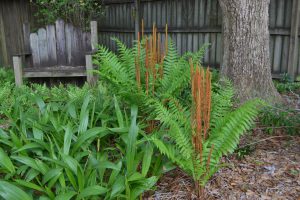
Under a tree canopy can be a low maintenance area. Ground orchids, cinnamon fern, and toadlily enhance a seated area. Photo by Beth Bolles, UF IFAS Extension Escambia County
Today’s plant options for shade are quite large. Below are just a few to consider.
Japanese fatsia is a large tropical looking evergreen that is very cold hardy. Attractive white flowers brighten the winter landscape.
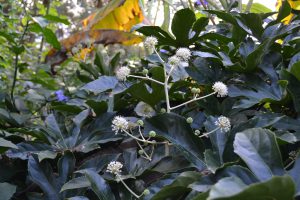
White flowers in winter are a bonus to enhance the large evergreen leaves of Fatsia. Photo by Beth Bolles, UF IFAS Extension Escambia County
Mountain snow pieris is a newer nursery offering with small white flowers during winter. Plants will need some moisture during warmer months.
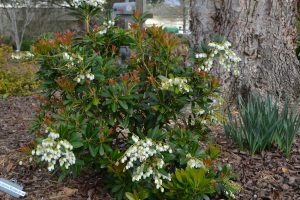
White blooms of Mountain Snow pieris in winter brighten an area. Photo by Beth Bolles, UF IFAS Extension Escambia County
Persian shield offers iridescent purple and silver foliage during warmer months. This plants would be considered an annual in most landscapes.
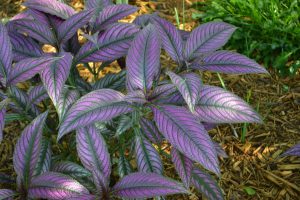
Even though it is an annual in most gardens, Persian shield brightens any shady spot. Photo by Beth Bolles, UF IFAS Extension Escambia County
The added benefit of landscaping under trees is that you have a natural self mulching area. You may need to dress up a few areas with additional mulch or redistribute leaves every so often so they don’t become to thick around plants. For more ideas on shade tolerant plants, visit the Escambia County Demonstration Gardens, 3740 Stefani Road, Cantonment, FL.












